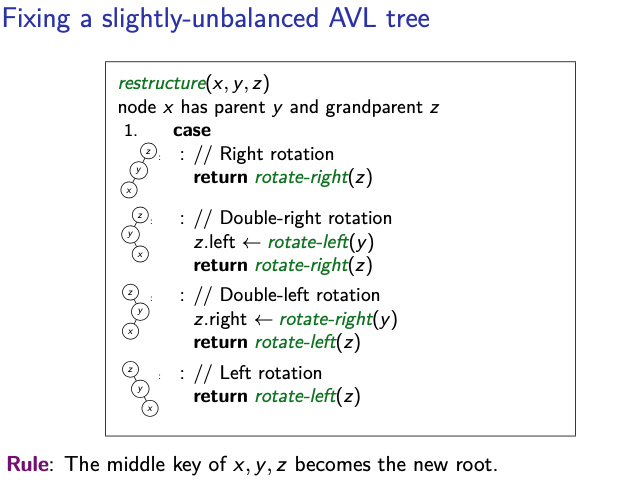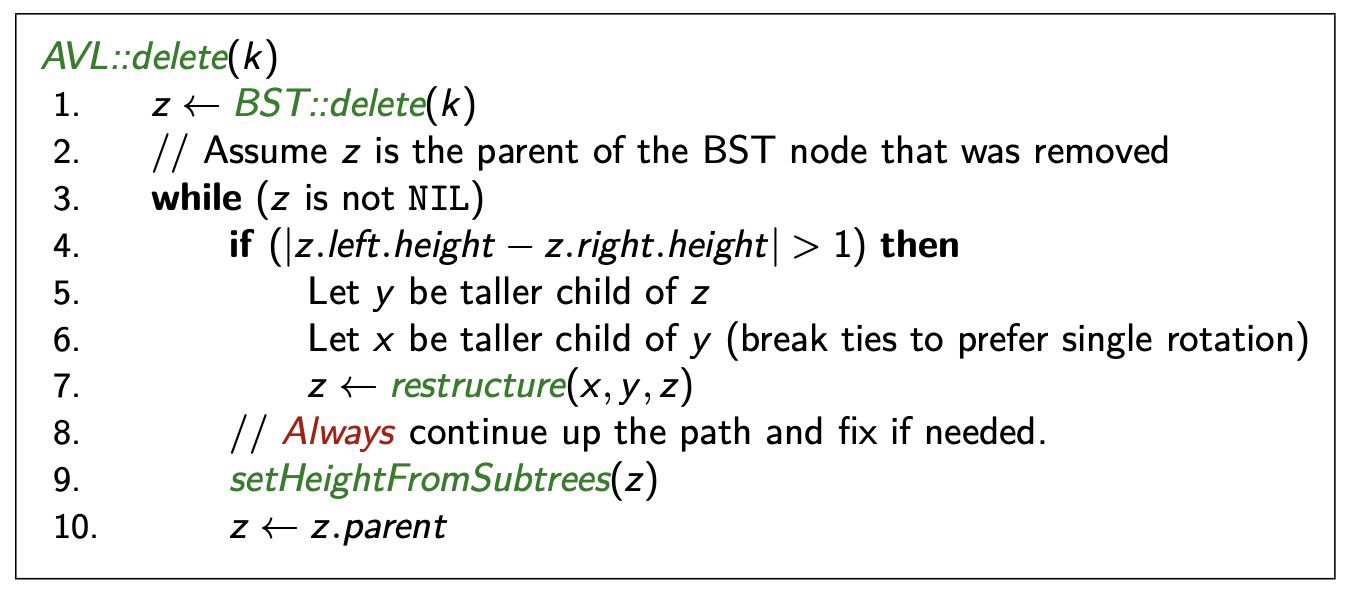AVL Tree
An AVL Tree is a Binary Search Tree with additional height-balance property at every node: The heights of the left and right subtree differ at most 1.
Convention: height(empty tree) = -1 AVL if at any node, (height of right subtree) - (height of left subtree )
- balance(v) = -1 means v is left-heavy
- balance(v) = +1 means right-heavy
We can either store the balance at each node or the height of its subtree.
Theorem
The height of an AVL Tree is always Theorem: An AVL tree on n nodes has height. search, insert, delete all cost
Formula
Minimum # nodes in a tree is given by . Where 1 is the root, is left and is right. So we start with N(0) which is 0, and N(1) is 2, then to find the next one that is N(3) we apply N(0) + N(1) + 1. Always the two previous +1.
Insertion in AVL Tree
Inserting into an AVL Tree is the same as inserting into a Binary Search Tree but it can potentially disrupt the balance so we need to restore the AVL properties by doing [Rotations].
Note
z: unbalanced y: depper child x: deeper child
AVL::insert(k, v):
z ← BST::insert(k, v) // Insert (k, v) into the AVL tree as a leaf node, returns the node z where k is now stored
while (z is not NIL):
if (|z.left.height - z.right.height| > 1):
// z is imbalanced, we need to perform rotations to restore balance
y ← taller child of z
x ← taller child of y
z ← restructure(x, y, z) // Restructure the tree to restore balance
// We can argue that we are done here since the tree is balanced now
break
setHeightFromSubtrees(z)
z ← z.parent
setHeightFromSubtrees(u)
u.heigth ← 1 + max{u.left.height, u.right.height}Restoring the AVL Property: Rotations
There are 4 cases:

AVL Deletion
We do a Binary Search Tree delete.
Pseudocode:
 When choosing , we need to choose the one that does the lest amount of rotations. The easier one.
When choosing , we need to choose the one that does the lest amount of rotations. The easier one.
Time complexity of AVL Tree
- search: total cost
- delete: total cost
- worst-case for all operations: good for searching unlike Heap (Memory) which is better for inserting and deleting.
Questions
-
What is the minimum number of nodes in an AVL tree of height?
-
When inserting into an AVL tree, what is the most number of rotations that you will have to perform?
- 2
-
What is the most number of rotations that we will have to perform if we delete from an AVL tree?
- height of the tree?
-
What is the rotation needed to correct a right-right imbalance in an AVL tree?
-
What is the minimum number of nodes in an AVL tree of height 8?
- 88
-
If you are given all numbers ahead of time, it is possible to create an AVL tree containing all numbers in time.
- False, why???
-
Inserting the same set of items into an AVL tree will always result in the same AVL tree, regardless of the order they are inserted.
- False
-
An AVL Tree with nodes always has the minimum height over all BSTs with nodes.
- False
-
When inserting a key into an AVL Tree, the newly inserted node will always be a leaf after the insertion is complete.
- False, might be rebalanced through Tree Rotation
-
Suppose AVL-Insert calls restructure on a node with balance factor +2, while its right child has balance factor 0. In this case, the imbalance will be fixed by:
- Invalid. This situation cannot occur.
-
Every heap satisfies the AVL height-balance property but not every AVL tree satisfies the heap structure property.
- True, heap property makes it that it won’t violate height-balance property of AVL trees, but AVL tree does not have the property of ordering elements as heaps. Where the node is bigger than its children for a max-heap for instance.
- In summary, AVL trees ensure height balance for efficient searching, while heaps maintain a specific structure for efficient extraction of extreme elements.